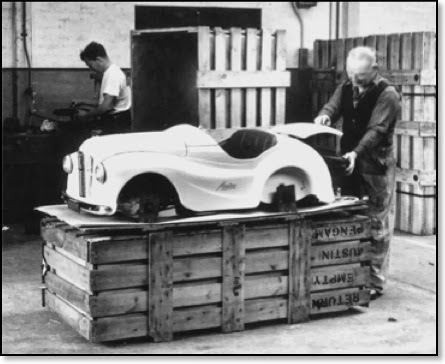 |
| Image Goodwood Revival |
How did the J40 come to be produced?
It was in 1943 that Parliament passed an act that recognised that many miners were been struck down with what the miners called "The Dust" (pneumoconiosis’s). The Government decided to encourage employers to give ex-miners employment. It was stated that in 1945 there were over 5,000 miners suffering from this disease. The plan was that they would build a Toy Pedal Car based on the current models. To keep the cost down, it would use metal off-cuts.
Leonard Lord, Chairman of the Austin Motor Co who in April 1946 summoned Rod Phillips who was an Artist and Jim Blake who had joined him after serving in the war, (it was a government directive that for person who was employed before the war, his employer would have to offer them their old job back on returning to civilian life.
Both Rod and Jim had no experience of body design and the tooling needed. This is where a third member Alf Ash joined the team who had the expertise.
The team were given a disused workshop in South Works in which to set up a design office and experimental build. So it was down to looking at the specification.
a) Suitable for children in the age range four to nine.
b) Must be able to have room in the front for a smaller brother or sister.
c) Bonnet and boot to open.
d) Lights that work along with a dummy engine
b) Must be able to have room in the front for a smaller brother or sister.
c) Bonnet and boot to open.
d) Lights that work along with a dummy engine
Producing a full size car is easy as all the tools and processes are in place. The main problem, how do you produce a car for children, so it was necessary to take measurements of a child. Alf Ash was the only one of the team of three who had children, so his eight years child Marcia was measured that very night. From these measurements next day a full size 2D template was made. Now the engineering drawing could be worked on.
So starting from the bottom, the first think was to look at what was the smallest tires available. This turn out to be Dunlop 12 inch cord tires which were fitted on 8 inch wheels. The body had to mirror the range of full size models with the alligator bonnets, chrome grilles along with the characteristic headlamps.
 |
| The first Prototype made for Marcia. |
So now it was on to the next prototype, JOY 2, this had to be made a lot lighter and be capable of being manufactured. Various changes were made, the main one was to improve the pedal system, by converting from bicycle motion to the forward backward system. With these changes made, the car was loaned out to management families to see how it would cope with the real world of children.
JOY III was a based on a pre-war Twin-Cam racer, which will come in a later post.
However, unknown to the team the Austin Experimental Department had been given the task of producing a wooden mock up of a pedal car, using the rear end of JOY 1. The front end would be based on the A40 Devon which had not been announced yet.
It was time to start on the next phase, JOY IV which would have a front end like the new A40 Devon. Although having seen the full size prototype, it was a case of memorising what they saw and transferring it on to the JOY IV.
Soon it was time to show it to management. The unveiling ceremony was well received, its metallic blue body must have looked quite stunning along with the light fawn leather trim.
Jim now was to get new members for this team who could turn the prototype into a production model. The first task was to break down the body into separate panels that could be pressed out and then spot welded together. The JOY IV would now be called JOY 40, this was soon changed to J40, with the J standing for Junior.
The tooling was ordered, it was then that various supplier’s, such as Dunlop and Lucas were asked to quote. One interesting contract was with Champion to supply sparking plugs which were actually faulty, so they probably came free. Every item would have to receive a part number.
Production started in 1949 and on the 15 September 1971 the last of the Joy Cars were made, all of them going to UK customers. At this point the production total from 1955 to 1971 was 32,098. It is believed that the figure from 1949 to 1955 was about 1,500 Joy 40.
Today the Austin's are used at the Goodwood Revival, with a grid full of 30 Austin J40 pedal cars competing in the two-part race. The results are declared on aggregate timing. This inspiring race for vintage Austin J40 pedal cars was declared a unanimous success last year, and was repeated this last September in response to public demand. With an average age of 8 years old, the Settrington Cup competitors will once again pedal a short circuit around the main Goodwood grid/pit lane with a Le Mans-style running start, and a chicane. Each competitor wore wear period overalls and a 1950s-style crash helmet.
 |
| Image Goodwood Revival |
 |
| Image Goodwood Revival |
 |
| Image Rii Schroer |
 |
| Image Rii Schroer |
 |
| Image Rii Schroer |
 |
| Image Rii Schroer |
 |
| Image Goodwood Revival |
To share comment, this is the place to click.




No comments:
Post a Comment